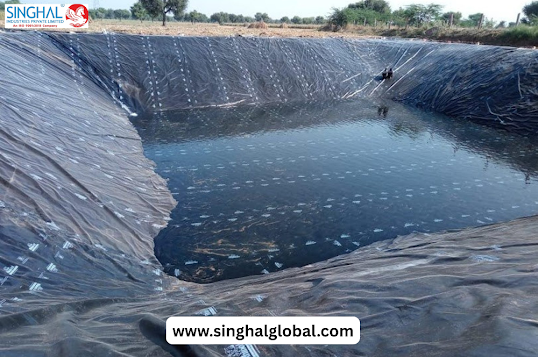HDPE Geomembrane Technology: Safe, Strong, and Sustainable
In the tireless quest for sustainable containment solutions, HDPE (High-Density Polyethylene) geomembrane technology is the first established technology within civil and environmental engineering. These engineered barriers are much more than plastic liners, as they represent an evolution of materials science and use, with containment solutions that are proven, extremely robust, and ever sustainable.
The Proverbial Foundation: Initial Safety: Impermeability and Chemical Resistance
The first strength of HDPE geomembrane technology is that it offers an impermeable barrier. This state comes from the composition of High-Density Polyethylene, with it's dense, highly crystalline molecular structure. HDPE unlike a lot of engineered materials with plastic components consists of tightly packed polymers, resulting in a solid barrier to stop liquid and vapour from moving through it and sucessful y sealing contaminants.
Adding to this impermeability is the impressive chemical resistance of HDPE geomembrane. HDPE geomembranes (and geotextiles), are largely inert to a wide range of aggressive chemicals, like strong acids, alkalis, and various organic sundries that are typically found in industrial waste, leachate from landfills, or saline water in aquaculture. The chemical resistance of the geomembrane means that the geomembrane itself is not degraded or leaching its own harmful substances into the environment, and it ideally would be performing its protective function for decades.
Engineered Strength: Durability and Material Performance
In addition to its chemical resistance, HDPE geomembrane technology has very good mechanical strength, making it a strong material for difficult applications. These liners have very high tensile strength meaning they can tolerate very high pulling forces without tearing. They also exhibit very good puncture resistance which is essential for preventing damage by sharp objects in the subgrade and during installation. Finally, they exhibit very good tear resistance so that should a small tear start, it is unlikely to propagate quickly through the sheet.
A significant factor in their durability and longevity is the use of carbon black in their production process. This UV stability combined with exceptional resistance to environmental stress cracking means that, in either an irrigation reservoir or aquaculture farm, the HDPE geomembrane pond liner will keep its integrity and performance over many years even in extreme outdoor conditions. The same stringent international and national specifications that allows the manufacture of HDPE geomembranes to be mechanically controlled during production and provides assurance and confidence regarding their long-term performance.
A Sustainable Solution: Longevity & Resource Efficiency
The sustainable component of HDPE geomembrane technology lies in multiple aspects of its lifecycle. Quite simply, its quality and longevity contribute to sustainability. HDPE geomembranes significantly delay potential recurrent replacement activities which depend on the type of material selected, preserving raw materials and waste for generations. As a result of their lifespan, HDPE geomembranes represent a true resource-efficient solution for sustainable long-term infrastructure development.
Second, HDPE, despite being petrochemical-based, is trending towards more efficient production processes and a smaller environmental footprint by reducing energy consumption, and emissions. Plus, HDPE is also highly recyclable. Post-consumer and post-industrial HDPE geomembrane can be reclaimed, reprocessed, and re-extruded into new HDPE products, completing the circular economy loop where reliance on virgin material is reduced, plus it keeps material out of landfill. On top of that, because HDPE is lightweight, and less material also means less transportation, less consumption of fuel, and fewer greenhouse gas emissions in the logistics.
Ultimately, the capacity of HDPE geomembranes offers environmental sustainability in handling the sustainability issues is bring sustainability. As an illustration of this, in the water management sector, an HDPE Geomembrane Liner in India used for canal lining and reservoir construction thus reducing the potential water is wasted through seepage, and is an important component in the water conservation program aimed at reducing water loss in water poverty areas. In mining, they contain process solutions and tailings, whereby limiting exposure and pollution with the ambient environment. Therefore, as outlined HDPE geomembrane functions to limits potential harm to a natural resource, and limits absolute harm in terms of the local environment culminates for a strong argument for a case of sustainable technology.
Real World Impact: From Waste Management to Water Conservation
HDPE geomembrane technology is proving useful in many real world applications. Likewise, water containment relies on the universal HDPE geomembrane pond liner: pond liners are often used in irrigation ponds, fish farms, decorative lakes, and municipal water supply reservoirs as they allow for responsible water storage. The mining industry uses HDPE Geomembrane Specifications to contain process chemicals or mining waste by lining heap leach pads and tailing dams to create a barrier against environmental impacts.
Conclusions
HDPE geomembrane technology is a great example of how material science can be beneficial in finding solutions that meet our collective needs when the material selection criteria are met. HDPE eomembrane Specifications is naturally safe because of its impermeable and resistant properties to separation of petroleum chemicals from stable ecosystems and the protection of public health. At the same time, its high strength properties and puncture resistance provide a reasonable expectation of performance over time against stresses.
Frequently Asked Questions
Q: What is the main purpose of an HDPE geomembrane pond liner?
A: The main purpose of an HDPE geomembrane pond liner is to provide an impermeable barrier that will prevent the flow of water or any liquid into the ground, and thus retained water or specific solutions in ponds, reservoirs and aquaculture farms.
Q: Are HDPE geomembrane liners subject to specific Indian standards?
A: Yes, HDPE geomembrane liners in India must meet specific Indian standards, including IS 16352:2020, which lays down the quality and performance criteria and suits different lining applications of HDPE geomembranes.
Q: Who is the largest manufacturer of HDPE Geomembranes ?
A: Singhal Global Private Limited is a prominent and widely recognized name among the largest manufacturers of HDPE geomembrane in the country, known for its extensive product range and widespread distribution..png)


Comments
Post a Comment